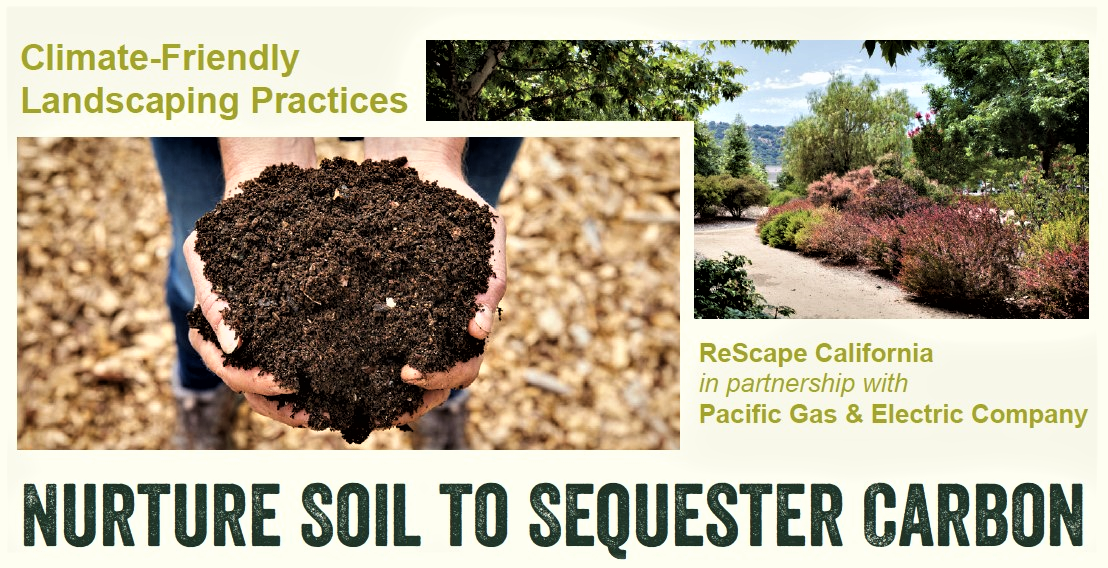
Carbon Sequestration to Mitigate Climate Change
ReScape and PG&E are partnering to offer an eight webinar lecture series on landscaping practices that address climate change, with a focus on carbon sequestration. The webinar topics are based on ReScape’s 8 Principles and will provide an overview of the problem and the solution vis-à-vis the Principles. There will be hands-on tips and best practices for sequestering carbon, reducing emissions, saving water and creating resilient landscapes; and include actionable steps with references to science-based data and additional resources. This speaker series is a part of ReScape’s Climate Change Consortium Demonstration Projects to educate about climate change landscaping challenges and the solutions available using regenerative practices.
Carbon Sequestration in the Landscape Series: #7 – Carbon Sequestration to Mitigate Climate Change
The embodied energy and carbon footprint of traditional landscape practices contribute directly and indirectly to greenhouse gas emissions and air pollution. As the amount of carbon dioxide in the atmosphere reaches new highs, solutions to the climate change crisis must be embraced by the entire landscape industry.
Healthy vegetation works together with soil rich in organic matter and beneficial microorganisms to remove carbon dioxide from the air and store it as soil carbon, an important strategy for addressing climate change. Strategies include regenerative soil management practices, such as applying compost and mulch, limiting and alleviating soil compaction, designing landscapes to protect mature trees, planting large stature trees, and choosing materials with low embodied energy and carbon footprint to mitigate climate change.
Date
- Apr 19 2021
- Expired!
Time
- 12:00 pm - 1:30 pm
Local Time
- Timezone: America/New_York
- Date: Apr 19 2021
- Time: 3:00 pm - 4:30 pm
Next Event
- AFSF Saturday Design Studio 2024
-
Date
- Apr 20 2024
-
Time
- 10:00 am - 11:30 am
Recent Posts
- AIA East Bay Member Wins AIA’s Membership Dues Autorenewal Sweepstakes
- Design Draw Build Project Wins 2024 CA Preservation Foundation Design Award
- Women in Architecture Held it’s First Annual Recognition Party!
- Take a Look at Our 1st Annual AIAS Design Competition
- Tim Nystrom: A Visionary Leader in Architecture | Member Spotlight
Recent Comments
- Our 2023 Member Appreciation Party was A Night to Remember! - AIA – East Bay Chapter on Congratulations to our 2024-2026 Board Members!
- 2023 Design Awards Winners Announced! - AIA – East Bay Chapter on 2023 Design Award Nominees Announced!
- Robert Cooley on Plumbing Fixtures in the 2022 Codes by Kerwin Lee, AIA
- AIA East Bay on AIAEB Launches New Membership Outreach Program
- madeleine@mzmdesignworks.com Zayas on Last Night’s Member Appreciation Party
Archives
- April 2024
- March 2024
- February 2024
- January 2024
- December 2023
- November 2023
- October 2023
- September 2023
- August 2023
- July 2023
- June 2023
- May 2023
- April 2023
- March 2023
- February 2023
- January 2023
- December 2022
- November 2022
- October 2022
- September 2022
- August 2022
- July 2022
- June 2022
- May 2022
- April 2022
- March 2022
- February 2022
- January 2022
- December 2021
- October 2021
- September 2021
- August 2021
- July 2021
- June 2021
- May 2021
- April 2021
- March 2021
- February 2021
- January 2021
- December 2020
- November 2020
- October 2020
- September 2020
- August 2020
- July 2020
- June 2020
- May 2020
- April 2020
- March 2020
- February 2020
- January 2020
- December 2019
- October 2019
- September 2019
- August 2019
- July 2019
- June 2019
- May 2019
- April 2019
- March 2019
- February 2019
- December 2018
- November 2018
- October 2018
- September 2018
- August 2018
- July 2018
- June 2018
- May 2018
- April 2018
- March 2018
- February 2018
- January 2018
Categories
- ADA/Accessibility
- Archinect
- ArchNews
- Awards
- CES
- Classified/Announcement
- Committees & Forums
- Design
- Emerging Professionals
- Large
- Lecture
- Licensure
- Medium
- Member Spotlight
- Monthly Program
- Networking/Social
- News
- Partners
- Professional Practice
- Programs & Events
- Small
- Small Firm Forum
- Student
- Tours
- Unbuilt
- Uncategorized
- User Groups
Responses